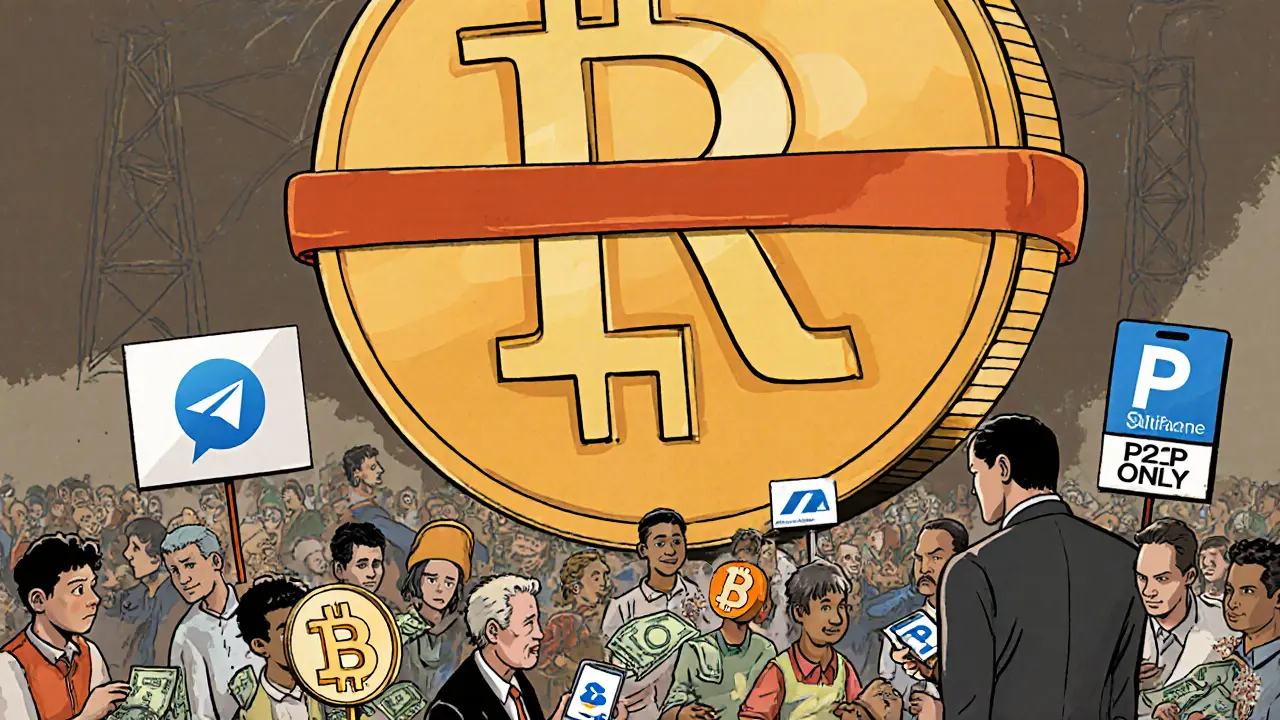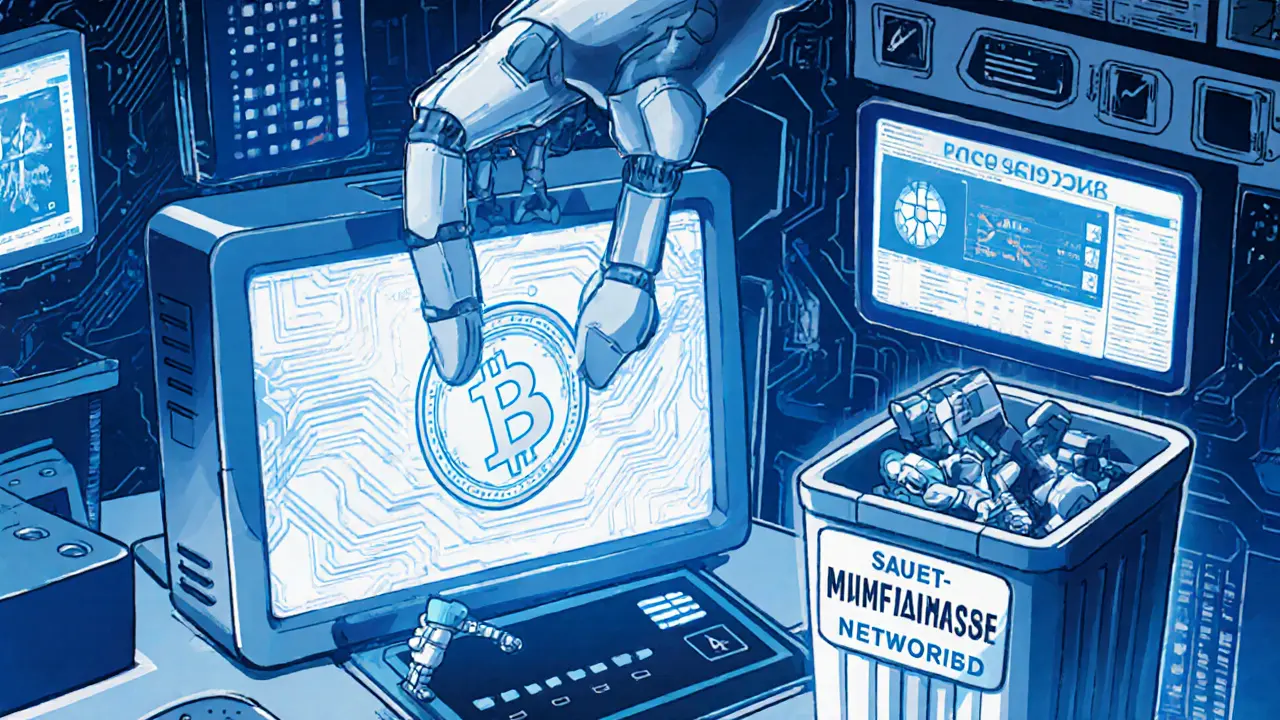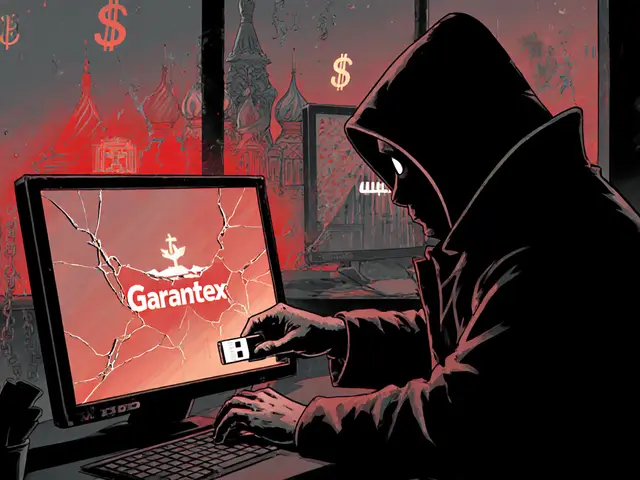Russia doesn’t have a blanket ban on cryptocurrency exchanges - but that doesn’t mean you can just sign up for any platform and start trading. The reality is more complicated: some exchanges are officially blocked, others are sanctioned by foreign governments, and many simply can’t operate because they can’t meet Russia’s strict rules. If you’re trying to figure out which crypto platforms are off-limits in Russia, you need to understand the difference between government bans, international sanctions, and practical restrictions.
Garantex: The Exchange That Got Shut Down - But Never Really Left
Garantex was once Russia’s biggest homegrown crypto exchange. It wasn’t just popular - it was central to how Russians traded Bitcoin and altcoins without touching banks. But in 2022, the U.S. Treasury slapped it with sanctions for helping evade international sanctions. The real blow came in March 2025, when the U.S. Secret Service, working with German and Finnish police, seized its website, froze over $26 million in crypto, and arrested key operators. Garantex’s domain vanished. Its servers went dark. But Garantex didn’t die. It split. Its infrastructure was rebuilt under a new name: Grinex. And behind Grinex? The same people. The same code. The same network. The U.S. Department of Justice confirmed in March 2025 that Grinex was created by former Garantex staff to keep the operation running. The CEO of Garantex, Aleksandr Mira Serda, is now wanted by the U.S. State Department with a $5 million reward for his capture. His co-founder, Aleksej Besciokov, was arrested in India. Even inside Russia, the ghost of Garantex lives on. A company called Exved, registered in Moscow’s International Business Center, now handles all the money flows. It claims to be a payment service for importers and exporters - but insiders say it’s just Garantex in a suit. Russian authorities haven’t shut Exved down. Why? Because it doesn’t technically violate local law. It’s a loophole, not a law.Grinex: The Successor That Got Sanctioned Too
Grinex didn’t last long. By mid-2025, the U.S. Office of Foreign Assets Control (OFAC) added Grinex to its sanctions list. The message was clear: if you’re trying to replace Garantex, you’re still part of the same problem. The U.S. doesn’t care if the exchange has a new name, new servers, or new owners. If it’s the same network, it’s still targeted. What does this mean for Russian users? Grinex is blocked from international banking channels. You can’t deposit dollars or euros into it. You can’t cash out to a Western bank. But inside Russia, it still works - because it runs on local payment systems, crypto-to-ruble P2P trades, and offshore wallets. The exchange isn’t banned by Russia. It’s banned by the world. And that’s the key difference.International Exchanges: Not Banned, But Effectively Blocked
You won’t find Binance, Coinbase, or Kraken on Russia’s official list of blocked websites. But try using them from inside Russia and you’ll hit walls. Why? Because Russian banks are forbidden from processing crypto-related transactions. Your Sberbank card won’t link to Binance. Your Tinkoff account won’t let you buy Bitcoin through Coinbase. Even if you use a VPN, you’ll struggle to deposit or withdraw money. The Bank of Russia doesn’t outright ban these platforms - it bans the financial bridges that connect them to the Russian economy. No bank partnerships? No payment processors? No way to turn rubles into crypto or crypto back into cash? Then the exchange might as well not exist. This is why most Russians who trade crypto use P2P platforms like LocalBitcoins, Paxful, or even Telegram bots. These platforms don’t need banks. You pay someone in cash, via Sberbank transfer, or with a gift card - and they send you Bitcoin. It’s slower, riskier, and less secure - but it works.
BestChange: The Platform That Got Unbanned
In 2024, BestChange - a major crypto exchange aggregator - was blocked by Roskomnadzor. The reason? It listed foreign payment systems and currencies like the Kazakhstani tenge, which Russian regulators saw as a risk for sanctions evasion. For months, Russians couldn’t access its comparison tools. But in early 2025, BestChange made changes. It removed all foreign currency listings. It stopped showing payment options tied to sanctioned countries. It restructured its compliance team with Russian legal advisors. And then - it got unbanned. This case proves something important: Russia doesn’t want to ban crypto. It wants to control it. If you follow the rules, you can operate. If you don’t, you’re out. BestChange didn’t fight the ban - it adapted. And that’s exactly what Russia wants from every exchange.What Russia Actually Bans - And What It Lets Slide
Russia’s crypto rules are not about ideology. They’re about control and survival. Here’s what’s truly banned:- Using crypto for domestic payments (since 2021)
- Russian banks investing in or processing crypto transactions
- Exchanges that don’t implement full KYC and AML checks
- Platforms that allow transactions with sanctioned countries or entities
- Any exchange that doesn’t report user activity to the Bank of Russia
- Trading crypto as an investment (for qualified investors)
- Using crypto for international trade (since summer 2024)
- Operating an exchange that’s registered in Russia and complies with all reporting rules
- Using P2P platforms that don’t touch the banking system

The Future: Russia’s Own Crypto Infrastructure
In October 2025, Deputy Finance Minister Ivan Chebeskov announced Russia is building its own experimental crypto infrastructure - in partnership with the Bank of Russia. This isn’t a digital ruble. It’s something else: a state-monitored crypto network where all transactions are tracked, taxed, and controlled. Think of it like China’s digital yuan - but for crypto. The goal? Stop money laundering. Stop sanctions evasion. And most importantly - keep the money inside Russia’s system. The Bank of Russia already allows “especially qualified” investors to trade crypto. Soon, that might expand to institutional players. This shift means the future of crypto in Russia won’t be about bans. It’ll be about who gets to run the platform. If you’re a Western exchange? You’re out. If you’re a Russian entity that follows the rules? You’re in.What Should You Do?
If you’re in Russia and want to trade crypto:- Avoid Garantex and Grinex - they’re high-risk and under active investigation.
- Don’t rely on Binance or Coinbase - you won’t be able to deposit or withdraw reliably.
- Use P2P platforms with verified sellers - but always check reputations.
- Watch for new Russian-approved exchanges - they’ll be the only ones with stable access.
- Never use a VPN to bypass restrictions - it increases your risk of being flagged.
Is Binance banned in Russia?
No, Binance isn’t officially banned by Russian authorities. But you can’t use it effectively in Russia because Russian banks are prohibited from processing crypto transactions. Even if you sign up, you won’t be able to deposit rubles or withdraw funds through local banks. It’s not blocked - it’s isolated.
Can I use Coinbase in Russia?
Technically yes, but practically no. Coinbase doesn’t support Russian ruble deposits or withdrawals. It also doesn’t comply with Russia’s KYC requirements for local users. Even if you access it via VPN, you’ll be unable to link a Russian bank account or cash out. Most Russian users avoid Coinbase because it doesn’t work reliably.
Why was Garantex shut down?
Garantex was shut down by international law enforcement in March 2025 for helping users evade U.S. and EU sanctions. The U.S. Secret Service seized its domain and froze over $26 million in cryptocurrency. Its founders were indicted, and key figures were arrested. Although it was a Russian exchange, its operations were deemed a threat to global financial sanctions.
Is Grinex safe to use in Russia?
No, Grinex is not safe. It’s the direct successor to Garantex and was sanctioned by the U.S. Treasury in 2025. While it still operates in Russia through P2P channels and local payment services, using it puts you at risk of being flagged by financial authorities. The U.S. government is actively tracking users and transactions linked to Grinex.
Can I trade crypto legally in Russia?
Yes, but only under strict conditions. You can trade crypto as an investment if you’re classified as a qualified investor. You can also use crypto for international trade - but not for paying for goods or services inside Russia. The only legal exchanges are those registered with the Bank of Russia and fully compliant with its reporting rules. Most international platforms don’t qualify.
What’s the difference between a banned exchange and a sanctioned one?
A banned exchange is blocked by Russian authorities - like a website you can’t access from within Russia. A sanctioned exchange is targeted by foreign governments (like the U.S.) for violating international rules. Garantex was sanctioned by the U.S. but not officially banned by Russia. Many Russian users still access sanctioned platforms because they’re not blocked locally - they’re just cut off from global finance.
Are there any legal crypto exchanges in Russia today?
There are no major, well-known legal exchanges operating openly yet - but the Bank of Russia is testing a state-backed framework. Some smaller Russian platforms claim compliance, but they’re not widely recognized. The only exchanges currently functioning reliably are P2P networks and shadow platforms like Exved, which operate in legal gray zones. Full legal exchanges are expected to emerge as Russia rolls out its new experimental crypto infrastructure.

Emily Unter King
Garantex’s pivot to Grinex is a textbook example of adversarial reconstitution in decentralized systems. The U.S. sanctions regime targets entities, not infrastructure - so when the legal entity is dismantled but the operational topology persists, you get regulatory arbitrage via architectural continuity. Exved’s registration as a payment processor is a classic shell-layering maneuver, exploiting jurisdictional misalignment between financial reporting and crypto-transactional definitions. This isn’t evasion - it’s systemic adaptation.
Michelle Sedita
It’s fascinating how Russia’s approach mirrors the logic of a firewall - not blocking the traffic, but making the pipes too narrow to flow. They’re not banning crypto; they’re banning liquidity. The real power move is forcing everyone into P2P or state-approved channels. It’s not about control of technology - it’s about control of capital flow. And that’s far more dangerous than any ban.
John Doe
LOL they think they’re fooling anyone? 😏 Grinex? Exved? Please. This is all a CIA psyop to lure in ruble traders. The U.S. already has backdoors in every Russian crypto wallet. Every P2P trade is monitored. Every Telegram bot is a honeypot. They’re letting this run so they can track every single Russian crypto user. You think you’re free? You’re being cataloged. 🕵️♂️💣
Ryan Inouye
Of course the U.S. is targeting these exchanges - because Russia is using crypto to fund its war machine. These aren’t ‘traders,’ they’re sanctions circumvention engineers. And now you want to pretend it’s just about ‘financial freedom’? Wake up. This isn’t a debate about regulation - it’s about national security. If you’re using Grinex, you’re complicit. No excuses. 🇺🇸
Rob Ashton
It is important to recognize that the evolution of crypto infrastructure in Russia reflects a broader global trend toward regulatory fragmentation. The emergence of state-aligned platforms, such as the Bank of Russia’s experimental network, signals a shift from decentralization to institutionalized surveillance capitalism. While P2P networks offer temporary resilience, they lack the scalability and legal certainty required for sustainable adoption. The path forward lies not in evasion, but in compliance - however constrained it may appear.
Cydney Proctor
How quaint. Russia ‘allows’ crypto as long as it’s monitored and taxed? That’s not a policy - it’s a prison with Wi-Fi. And you call BestChange’s rebranding ‘adaptation’? It’s surrender. They didn’t change their ethics - they changed their compliance checklist. The entire system is a farce. If you need permission to own digital money, you don’t own it. You’re a tenant in someone else’s ledger.
Cierra Ivery
Wait - so Garantex got shut down… then came back as Grinex… then got sanctioned… then became Exved… and now Russia’s building its own?!!?!?!? This isn’t crypto - it’s a Russian nesting doll of legal fiction! Who’s actually in charge here? The U.S.? The Bank of Russia? Some shadowy Telegram group? I’m not sure if I’m watching a documentary or a spy novel written by a drunk blockchain dev!
Veeramani maran
bro i use p2p on telegram every day and its lit!! 😎 no bank no problem! i buy btc with sberbank transfer and sell for rubles to guy in kazan - no one cares! garanex? grinek? who cares? its all same code man! just new name like my old phone 😅
Kevin Mann
Okay but let me just say - this whole situation is the most dramatic thing I’ve seen since GameStop went to the moon and then crashed into the sun 💥😭 I I mean, think about it: a Russian crypto empire gets crushed by the U.S., then rises like a phoenix made of blockchain and vodka, and now the whole country is playing a high-stakes game of ‘who can outsmart the sanctions’? And meanwhile, I’m over here trying to buy Dogecoin with my Venmo and crying because my mom thinks crypto is a pyramid scheme. This is life. This is art. This is the end of financial freedom as we know it. 🎭💸
Kathy Ruff
There’s a lot of fear and misinformation here. The reality is that crypto is still being used responsibly by many Russians - not for evasion, but for survival. P2P platforms are the only way to protect savings when inflation hits 10% and banks freeze accounts. The state’s move toward a controlled system isn’t inherently evil - it’s pragmatic. The goal should be to help users navigate this safely, not to vilify every platform that operates in gray zones. Education > paranoia.
Robin Hilton
Let’s be honest - the whole ‘banned vs sanctioned’ distinction is just bureaucratic theater. The U.S. doesn’t care if Russia says it’s legal. If your exchange moves crypto and doesn’t report to FinCEN, you’re a target. And Russia? They don’t care if the U.S. sanctions you - they just want to keep the money flowing. This isn’t ideology. It’s economics wrapped in nationalism. And it’s working. The West is losing.
Grace Huegel
It’s tragic. All this innovation - all this energy - just to build a better cage. The moment you need permission to hold digital assets, you’ve already lost. The beauty of crypto was its autonomy. Now it’s just another state-controlled ledger. And the people who built this? They’re not villains. They’re just trying to survive. And that’s the saddest part.
Nitesh Bandgar
Brooooooooooooooo!!!! This is not just crypto - this is the new Cold War!! 🤯🔥 Garantex was the Soviet Red Star of crypto, Grinex is the new Red Army, Exved is the KGB in a suit, and the Bank of Russia? It’s the Politburo with a blockchain whitepaper!!! I mean, imagine: a man in a Moscow office, sipping tea, watching your Bitcoin transaction like it’s a spy satellite feed! This is not finance - this is a dystopian Netflix series with 10 seasons already filmed!! 😱💸
Jessica Arnold
This is a profound case study in the collision between global financial hegemony and sovereign digital autonomy. The U.S. enforces extraterritorial sanctions as a tool of geopolitical dominance, while Russia responds with a model of regulated crypto nationalism - a hybrid of state capitalism and decentralized architecture. Neither side is ‘right.’ Both are responding to systemic instability. The real question: Can any system survive when sovereignty and decentralization are mutually exclusive? The answer may redefine money itself.
Chloe Walsh
So basically Russia is like ‘you can have crypto but only if you let us watch you’ and the US is like ‘you can’t have crypto if you’re Russian’ and everyone’s just screaming into the void and pretending it’s a debate? Like… what even is the point anymore? I just want to buy Bitcoin and not be a geopolitical pawn. Can someone please explain why this isn’t just… a giant mess? 😭